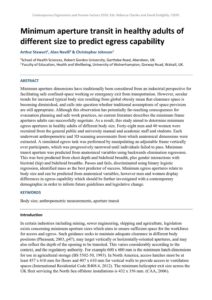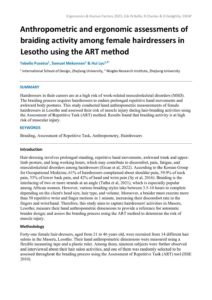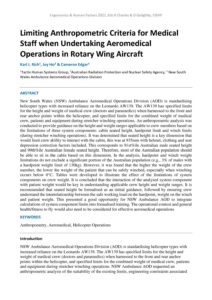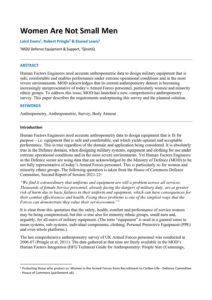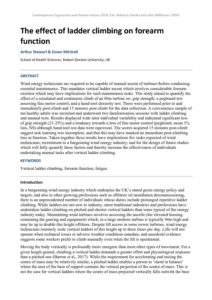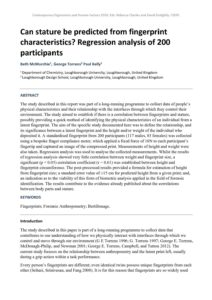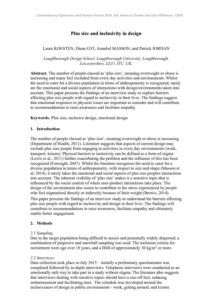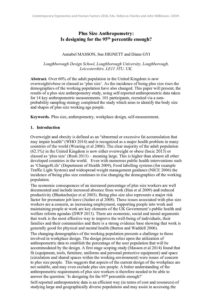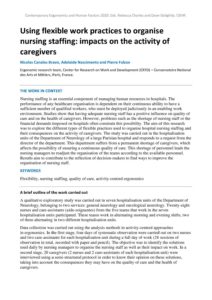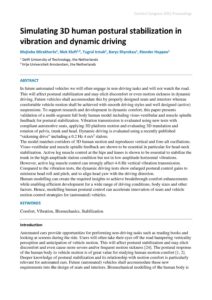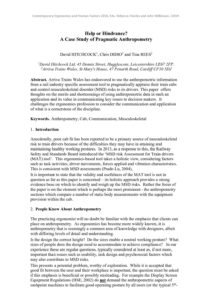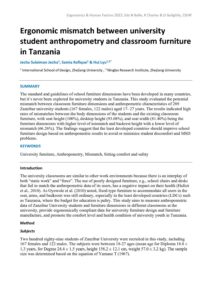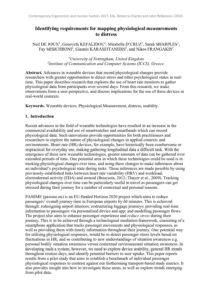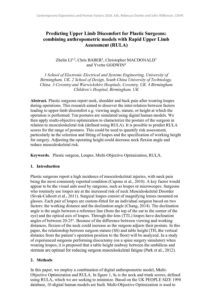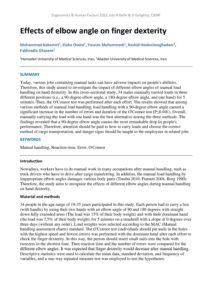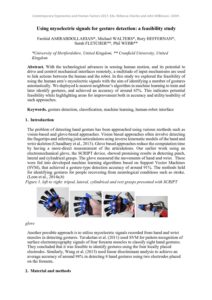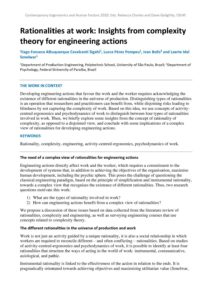Anthropometry
Minimum aperture transit in healthy adults of different size to predict egress capability
| Document | Author Arthur Stewart, Alan Nevill & Christopher Johnson |
| Abstract Minimum aperture dimensions have traditionally been considered from an industrial perspective for facilitating safe confined-space working or emergency exit from transportation. However, secular trends for increased typical body size resulting from global obesity mean that clearance space is becoming diminished, and calls into question whether traditional assumptions of space provision are still appropriate. Although this observation has potentially far-reaching consequences for evacuation planning and safe work practices, no current literature describes the minimum frame apertures adults can successfully negotiate. As a result, this study aimed to determine minimum egress apertures in healthy adults of different body size. Forty-eight men and 40 women were recruited from the general public and university manual and academic staff and students. Each underwent anthropometric and 3D scanning assessments from which anatomical dimensions were extracted. A simulated egress task was performed by manipulating an adjustable frame vertically over participants, which was progressively narrowed until individuals failed to pass. Minimum transit aperture was predicted from anatomical variables using backwards elimination regression. This was best predicted from chest depth and bideltoid breadth, plus gender interactions with bicristal (hip) and bideltoid breadths. Passes and fails, discriminated using binary logistic regression, identified mass as the best predictor of success. Minimum egress apertures relate to body size and can be predicted from anatomical variables, however men and women display differences in egress capability which should be further investigated with a contemporary demographic in order to inform future guidelines and legislative change. |
Anthropometric and ergonomic assessments of braiding activity among female hairdressers in Lesotho using the ART method
| Document | Author Tebello Pusetso, Samuel Mekonnen & Hui Lyu |
| Abstract Hairdressers in their careers are at a high risk of work-related musculoskeletal disorders (MSD). The braiding process requires hairdressers to endure prolonged repetitive hand movements and awkward body postures. This study conducted hand anthropometric measurements of female hairdressers in Lesotho and assessed their risk of muscle injury during hair-braiding activities using the Assessment of Repetitive Task (ART) method. Results found that braiding activity is at high risk of muscular injury. |
Limiting Anthropometric Criteria for Medical Staff when Undertaking Aeromedical Operations in Rotary Wing Aircraft
| Document | Author Karl J. Rich, Joy Ho & Cameron Edgar |
| Abstract New South Wales (NSW) Ambulance Aeromedical Operations Division (AOD) is standardising helicopter types with increased reliance on the Leonardo AW139. The AW139 has specified limits for the height and weight of medical crew (doctors and paramedics) when harnessed to the front and rear anchor points within the helicopter, and specified limits for the combined weight of medical crew, patients and equipment during stretcher winching operations. An anthropometric analysis was conducted to provide guidance on the height and weight ranges applicable to crew members based on the limitations of three system components: cabin seated height, hardpoint limit and winch limits (during stretcher winching operations). It was determined that seated height is a key dimension that would limit crew ability to interact with the cabin, this was at 935mm with helmet, clothing and seat depression correction factors included. This corresponds to 91st%ile Australian male seated height and 99th%ile Australian female seated height. Therefore, most of the Australian population should be able to sit in the cabin based on this dimension. In the analysis, hardpoint and winch weight limitations do not exclude a significant portion of the Australian population (e.g., 3% of males with a hardpoint weight limit of 130kg). However, it was found that the higher the weight of the crew member, the lower the weight of the patient that can be safely winched, especially when winching occurs below 0°C. Tables were developed to illustrate the effect of the limitations of system components on crew weight. It is concluded that the interaction of the analysed system component with patient weight would be key in understanding applicable crew height and weight ranges. It is recommended that seated height be formalised as an initial guidance, followed by ensuring crew understand the interrelationship between the safe working load on the hardpoint, weight on the winch and patient weight. This presented a good opportunity for NSW Ambulance AOD to integrate calculations of system component limits into formalised training. The operational context and general health/fitness to fly would also need to be considered for effective aeromedical operations. |
Women Are Not Small Men
| Document | Author Laird Evans, Robert Pringle & Eluned Lewis |
| Abstract Human Factors Engineers need accurate anthropometric data to design military equipment that is safe, comfortable and enables performance under extreme operational conditions and in the most severe environments. MOD acknowledges that its current anthropometry dataset is becoming increasingly unrepresentative of today’s Armed Forces personnel, particularly women and minority ethnic groups. To address this issue, MOD has launched a new, comprehensive anthropometry survey. This paper describes the requirements underpinning this survey and the planned solution. |
The effect of ladder climbing on forearm function
| Document | Author Arthur Stewart & Dawn Mitchell |
| Abstract Wind energy technicians are required to be capable of manual ascent of turbines before conducting essential maintenance. This mandates vertical ladder ascent which involves considerable forearm exertion which may have implications for such maintenance tasks. This study aimed to quantify the effect of a simulated and continuous climb of an 80m turbine on: grip strength; a pegboard test assessing fine motor control; and a hand-tool dexterity test. These were performed prior to and immediately post-climb and 15 minutes post-climb for the data collection. A convenience sample of ten healthy adults was recruited and underwent two familiarisation sessions with ladder climbing and manual tests. Results displayed wide inter-individual variability and indicated significant loss of grip strength (21-25%) and a tendency towards a loss of fine motor control (pegboard, mean 5% loss, NS) although hand-tool test data were equivocal. The scores acquired 15 minutes post-climb suggest task learning was incomplete, and that this may have masked an immediate post-climbing loss in function. Taken together these results have implications for: tasks expected of wind technicians; recruitment to a burgeoning wind energy industry; and for the design of future studies which will fully quantify these factors and thereby increase the effectiveness of individuals undertaking manual tasks after vertical ladder climbing. |
Can stature be predicted from fingerprint characteristics? Regression analysis of 200 participants
| Document | Author Beth McMurchie, George Torrens Paul Kelly |
| Abstract The study described in this report was part of a long-running programme to collect data of people’s physical characteristics and their relationship with the interfaces through which they control their environment. The study aimed to establish if there is a correlation between fingerprints and stature, possibly providing a quick method of identifying the physical characteristics of an individual from a latent fingerprint. The aim of the specific study documented here was to define the relationship, and its significance between a latent fingerprint and the height and/or weight of the individual who deposited it. A standardised fingerprint from 200 participants (117 males, 83 females) was collected using a bespoke finger compliance meter, which applied a fixed force of 10N to each participant’s fingertip and captured an image of the compressed print. Measurements of height and weight were also taken. Regression analysis was used to analyse the collected measurements. Whilst the results of regression analysis showed very little correlation between weight and fingerprint size, a significant (p < 0.05) correlation coefficient (r = 0.61) was established between height and fingerprint circumference. The post-processed results provided a formula for estimation of height from fingerprint size; a standard error value of ±15 cm for predicted height from a given print; and, an indication as to the viability of this form of biometric analysis applied in the field of forensic identification. The results contribute to the evidence already published about the correlations between body parts and stature. |
Plus size and inclusivity in design
| Document | Author Laura KOESTEN, Diane GYI, Annabel MASSON, and Patrick JORDAN |
| Abstract The number of people classed as ‘plus size’, meaning overweight or obese is increasing and many feel excluded from every day activities and environments. Whilst the need to cater for a diverse population in terms of anthropometry is recognized, rarely are the emotional and social aspects of interactions with design/environments taken into account. This paper presents the findings of an interview study to explore barriers affecting plus size people with regard to inclusivity in their lives. The findings suggest that emotional responses to physical issues are important to consider and will contribute to recommendations to raise awareness and facilitate empathy. |
Plus Size Anthropometry: Is designing for the 95th percentile enough?
| Document | Author Annabel MASSON, Sue HIGNETT and Diane GYI |
| Abstract Over 60% of the adult population in the United Kingdom is now overweight/obese or classed as ‘plus size’. As the incidence of being plus size rises the demographics of the working population have also changed. This paper will present, the results of a plus size anthropometry study, using self-reported anthropometric data taken for 14 key anthropometric measurements. 101 participants, recruited via a non-probability sampling strategy completed the study which aims to identify the body size and shapes of plus size working age people. |
Using flexible work practices to organise nursing staffing: impacts on the activity of caregivers
| Document | Author Nicolas Canales Bravo, Adelaide Nascimento and Pierre Falzon |
| Abstract Nursing staffing is an essential component of managing human resources in hospitals. The performance of any healthcare organisation is dependent on their continuous ability to have a sufficient number of qualified workers, who must be deployed judiciously in an enabling work environment. Studies show that having adequate nursing staff has a positive influence on quality of care and on the health of caregivers. However, problems such as the shortage of nursing staff or the financial demands imposed on hospitals often constrain this possibility. The aim of this research was to explore the different types of flexible practices used to organise hospital nursing staffing and their consequences on the activity of caregivers. The study was carried out in the hospitalisation units of the Department of Neurology of a large Parisian hospital and responds to a request from the director of the department. This department suffers from a permanent shortage of caregivers, which affects the possibility of ensuring a continuous quality of care. This shortage of personnel leads the nursing managers to readjust the organisation of the teams according to the available personnel. Results aim to contribute to the reflection of decision-makers to find ways to improve the organisation of nursing staff. |
Simulating 3D human postural stabilization in vibration and dynamic driving
Help or Hindrance? A Case Study of Pragmatic Anthropometry
| Document | Author David HITCHCOCK, Chris DIDIO and Tina REES |
| Abstract Arriva Trains Wales has endeavored to use the anthropometric information from a rail industry specific assessment tool to pragmatically appraise their train cabs and control musculoskeletal disorder (MSD) risks to its drivers. This paper offers thoughts on the merits and shortcomings of using anthropometric data in such an application and its value in communicating key issues to decision makers. It challenges the ergonomics profession to consider the communication and application of what is a cornerstone of the discipline. |
Ergonomic mismatch between university student anthropometry and classroom furniture in Tanzania
| Document | Author Jecha Suleiman Jecha, Samia Rafique & Hui Lyu |
| Abstract The standard and guidelines of school furniture dimensions have been developed in many countries, but it’s never been explored for university students in Tanzania. This study evaluated the potential mismatch between classroom furniture dimensions and anthropometric characteristics of 289 Zanzibar university students (167 females, 122 males) aged 17- 27 years. The results indicated high rates of mismatches between the body dimensions of the students and the existing classroom furniture, with seat height (100%), desktop height (93.08%), and seat width (81.40%) being the furniture dimensions with higher level of mismatch and backrest height with a lower level of mismatch (66.26%). The findings suggest that the least developed countries should improve school furniture design based on anthropometric results to avoid or minimize student discomfort and MSD problems. |
Identifying requirements for mapping physiological measurements to distress
| Document | Author Neil DE JOUX, Genovefa KEFALIDOU, Mirabelle D’CRUZ, Sarah SHARPLES, Fay MISICHRONI, Giannis KARASEITANIDIS, and Nikos FRANGAKIS |
| Abstract Advances in wearable devices that record physiological changes provide researchers with greater opportunities to detect stress and other psychological states in real-time. This paper describes research that explores the use of heart rate monitors to gather physiological data from participants over several days. From this research, we make observations from a user perspective, and discuss implications for the use of these devices in real-world contexts. |
Predicting Upper Limb Discomfort for Plastic Surgeons: combining anthropometric models with Rapid Upper Limb Assessment (RULA)
| Document | Author Zhelin LI, Chris BABER, Christopher MACDONALD and Yvette GODWIN |
| Abstract Plastic surgeons report neck, shoulder and back pain after wearing loupes during operations. This research aimed to discover the inter-relation between factors leading to upper-limb discomfort e.g. viewing angle, stature, or height at which the operation is performed. Ten postures are simulated using digital human models. We then apply multi-objective optimization to characterize the posture of the surgeon in relation to musculoskeletal risk (defined using RULA). It is possible to predict RULA scores for the range of postures. This could be used to quantify risk assessment, particularly in the selection and fitting of loupes and the specification of working height for surgery. Adjusting the operating height could decrease neck flexion angle and reduce musculoskeletal risk. |
Effects of elbow angle on finger dexterity
| Document | Author Mohammad Babamiri, Elahe Oveisi, Younes Mohammadi, Rashid Heidarimoghadam & Fakhradin Ghasem |
| Abstract Today, various jobs containing manual tasks can have adverse impacts on people's abilities. Therefore, this study aimed to investigate the impact of different elbow angles of manual load handling on hand dexterity. In this cross-sectional study, 34 males manually carried loads in three different positions (i.e., a 90-degree elbow angle, a 180-degree elbow angle, and one hand) for 5 minutes. Then, the O'Connor test was performed after each effort. The results showed that among various methods of manual load handling, load handling with a 90-degree elbow angle caused a significant increase in the number of errors and duration of the O'Connor test (P≤0.001). Overall, manually carrying the load with one hand was the best alternative among the three methods. The findings revealed that a 90-degree elbow angle causes the most remarkable drop in people's performance. Therefore, attention should be paid to how to carry loads and choose the correct method of cargo transportation, and danger signs should be taught to the employees in related jobs. |
Using myoelectric signals for gesture detection: a feasibility study
| Document | Author Farshid AMIRABDOLLAHIAN, Michael WALTERS, Rory HEFFERNAN, Sarah FLETCHER, Phil WEBB |
| Abstract With the technological advances in sensing human motion, and its potential to drive and control mechanical interfaces remotely, a multitude of input mechanisms are used to link actions between the human and the robot. In this study we explored the feasibility of using the human arm’s myoelectric signals with the aim of identifying a number of gestures automatically. We deployed k-nearest neighbour’s algorithm in machine learning to train and later identify gestures, and achieved an accuracy of around 65%. This indicates potential feasibility while highlighting areas for improvement both in accuracy and utility/usability of such approaches. |
Rationalities at work: Insights from complexity theory for engineering actions
| Document | Author Tiago Fonseca Albuquerque Cavalcanti Sigahi, Lucca Pérez Pompeu, Ivan Bolis and Laerte Idal Sznelwar |
| Abstract Developing engineering actions that favour the work and the worker requires acknowledging the existence of different rationalities in the universe of production. Distinguishing types of rationalities is an operation that researchers and practitioners can benefit from, while disjoining risks leading to blindness by not capturing the complexity of work. Based on this idea, we use concepts of activity-centred ergonomics and psychodynamics of work to distinguish between four types of rationalities involved in work. Then, we briefly explore some insights from the concept of rationality of complexity, as opposed to a disjointed view, and conclude with some implications of a complex view of rationalities for developing engineering actions. |

